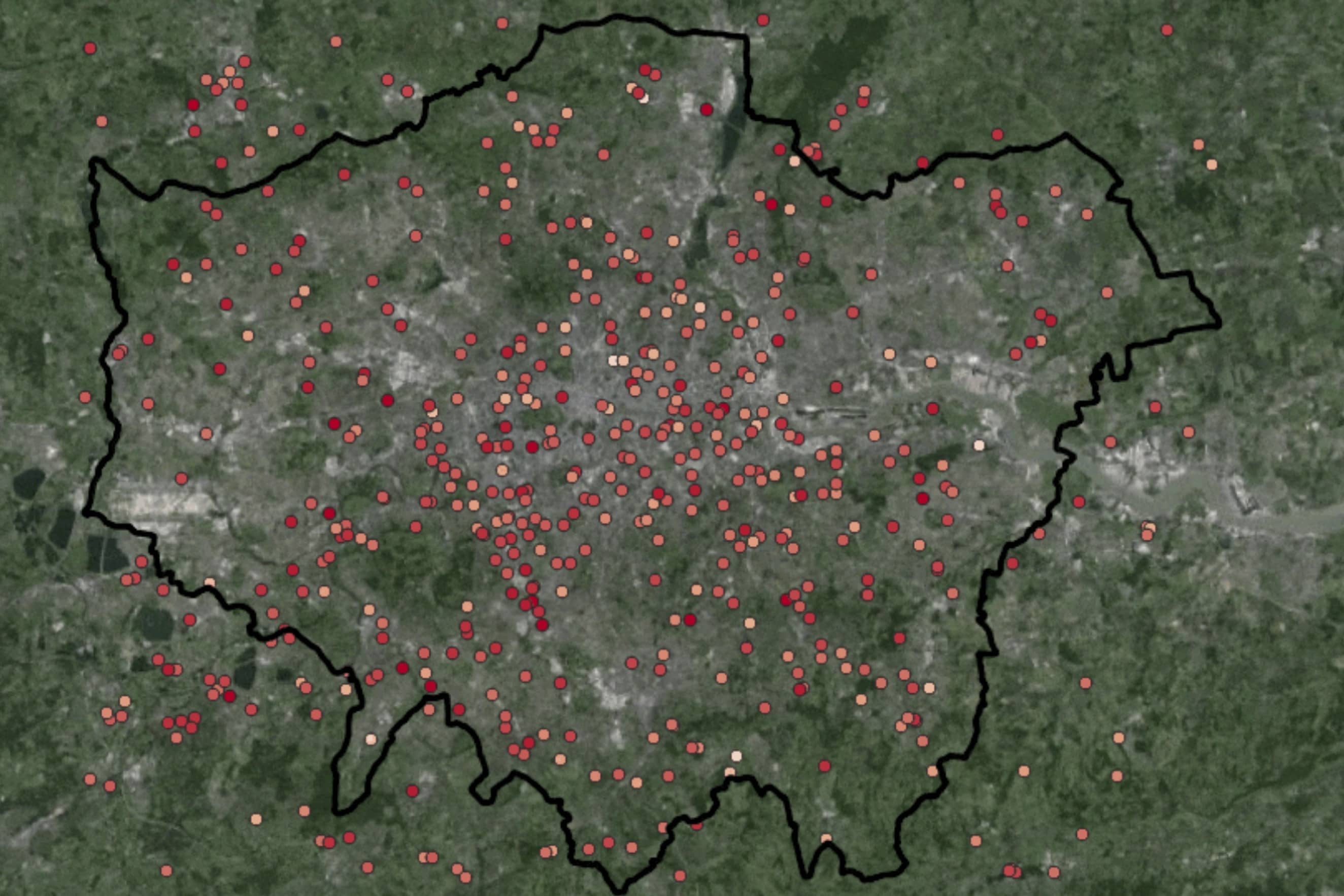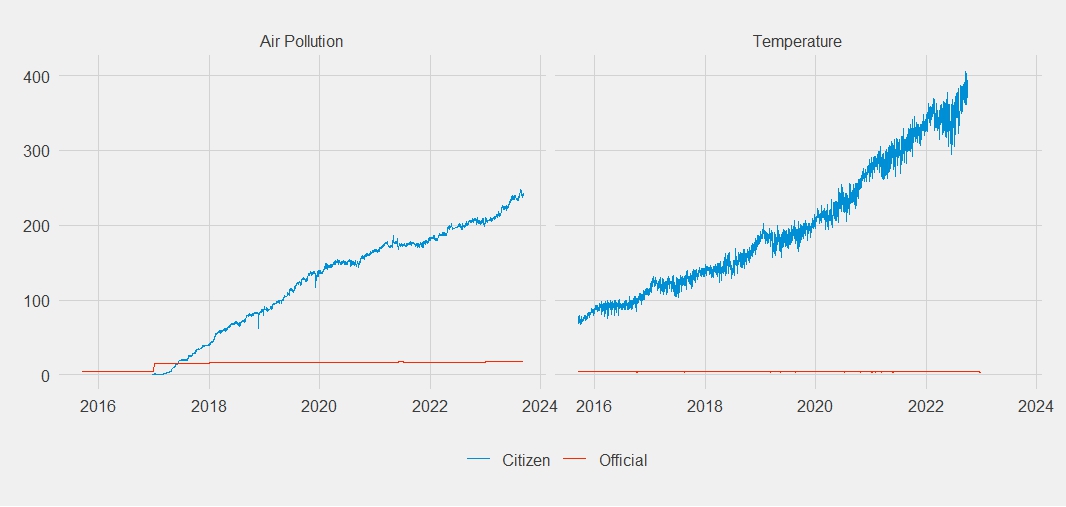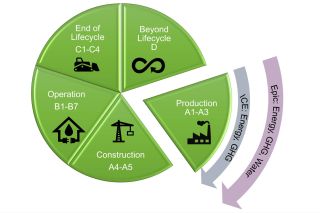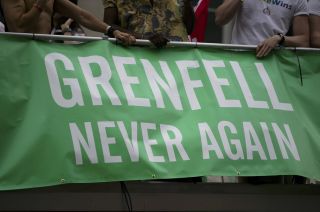
www.buildingsandcities.org/insights/commentaries/community-based-monitoring-urban-environmental.html
Community-based Monitoring of Urban Environmental Data

Looking forward: citizen science is changing the research landscape
Environmental data measured by the general public on their immediate local surroundings are providing new sources of fine-grained data in cities. Jonathon Taylor, Anna-Kaisa Viitanen & Alonso Espinosa (Tampere University) explain how this recent phenomenon can lead to a richer understanding of urban form, microclimates and environmental exposures.
The 21st century has seen rapid urbanisation, with cities now accounting for around 57% of the global population. This has led to increased density and sprawl of built-up areas (buildings and infrastructure), leading to increasing challenges to the environment and to health. For instance, worsening air pollution is causing more physical and mental health problems (Zang et al. 2022) and the Urban Heat Island (UHI) is accelerating rising temperatures in cities across the world (Heaviside et al. 2017).
The health risks from these environmental hazards are well documented and have been a focus of significant research, monitoring and tracking, and public awareness. In order to monitor environmental conditions, governments and scientists have typically deployed various static high precision weather and air pollution measurement stations. Measurement campaigns using vehicle transects have also been used to capture data via high quality instrumentation and conditions in urban areas are also routinely evaluated by computationally expensive simulation models and remotely-sensing via satellite imagery.
However, the past 10 years have seen a rapid growth in the amount of data available from Community-Based Monitoring (CBM) i.e. environmental data measured by the community. Several factors have contributed to its rise. Firstly, the prices and availability of instruments which can measure environmental conditions have significantly reduced. Secondly, the emergence of Internet-of-Things (IoT) connectivity means that many of these devices allow remote access and data to be uploaded to a server. And thirdly, growing public awareness of the harmful effects of these exposures may be leading to increasing uptake. This development has made it accessible for the general public to measure their immediate local environment, and often share this data publicly, leading to new and as-of-yet under-utilised sources of environmental data in cities.
Growth of CBM data in cities
To illustrate the rapid growth of publicly available CBM environmental monitoring data in cities, two examples are provided: Personal Weather Stations (PWS) and Air Quality Sensors (AQS). PWS provide opportunities to evaluate temperature exposures in urban environments and their surrounding rural areas, with platforms such as Weather Underground and Netatmo providing crowd-sourced climate data from PWS devices. AQS devices are increasingly being used to measure outdoor and indoor air pollution levels, with online platforms such as sensor.community and OpenAQ providing access to monitored data from low-cost devices such as those from Air Gradient, Megasense, as well as instructions such to assemble do-it-yourself (DIY) sensor systems.

The rapid growth of CBM is illustrated in a recent study that utilises PWS from Netatmo in London (Taylor et al. 2024) and AQS that measure PM2.5 (particulate pollution less 2.5 micrometers in diameter) from sensor.community across Europe. Focusing on London (PWS) and Berlin (AQS), (Figure 1) and now in many cities worldwide, AQS outnumber official monitoring stations.
This increased density of sensors in cities provides an opportunity to evaluate environmental exposures in urban environments and for examining conditions during extreme events.
This growth of CBM data provides significant research opportunities which are beginning to be realised. PWS have, for example, been used to examine urban climates (Brousse et al. 2022; Fenner et al. 2017; Potgieter et al. 2021; Varentsov et al. 2021), the effect of land cover on temperatures (Du et al. 2024; Taylor et al. 2024), act as an input to building physics models (Benjamin et al. 2021), and to validate and correct urban climate simulations (Brousse et al. 2023; Hammerberg et al. 2018). AQS have been used to study the potential to deliver real time air pollution data to local populations, to improve air quality predictions, to study the infiltration of air pollution (Bi et al. 2020; English et al. 2020; Wallace et al. 2022), and to supplement official data (Duvall et al. 2021; Gabrys 2017, 2017).
Challenges
Sensor reliability and comparability
The sensors themselves are less reliable and accurate than higher cost official instruments. PWS, for example, may lack sufficient radiation shields, while AQS have a range of limitations including an accuracy that depends on humidity and concentrations. This results in much greater uncertainty in measurements and lower reliability, and fall short of the necessary standards needed by instruments certified for regulatory monitoring. Sensors require regular calibration but information whether or not the calibration has been conducted, not to mention calibration specifications are not typically available. There are also a range of different types of sensors, raising issues of comparability and interoperability. While guidelines are available on the placement and use of these devices, it is not possible to know whether they have been followed. For example, PWS may be positioned close to radiative sources of heat, while AQS can be placed near an emission source, or in a way that restricts air intake.
Metadata
Engaging the public in data collection through low-cost sensors can expand data coverage, increase public awareness and involvement in environmental health issues, and empower communities to act for change. However, these devices are unlikely to be deployed by citizens in a standardised manner, and there is a lack of metadata about how these sensors are deployed. AQS data can have a variable indicating whether the sensors are indoors or outdoors, however there can be user configuration errors indicating placement and sensors assumed to be outdoors may in fact be located indoors, and vice versa. Location information is often available, but users can restrict the locational accuracy of the public information they share. For AQS located indoors, the types of buildings, floor-plans, and emission sources are not available from these CBM platforms for privacy reasons.
Location and biases
There may also be biases in geographical location. These devices are predominantly used by those with higher incomes and presumable with technical preparedness, leading to an under-representation of lower income areas. Conclusions drawn without accounting for these biases can lead to misinformed policies. CBM sensors are also largely located in residential areas. While this is useful to determine, for example, air pollution concentrations where people live and increasingly where they work, it can miss out on the roadside concentrations and industrial background concentrations that can help inform an individual's wider exposure.
Future directions
CBM has traditionally been seen as a means of public engagement, involving communities in planning and regulatory processes, or in academic research settings with specific or narrow focus. However, the pace at which the public has acquired sensors, and the huge amounts of data being constantly collected suggests an as-yet unrealised potential for research and policy development in urban areas. If this is to happen, then there is a need to overcome the challenges related to data quality and biases.
One way is to use advanced quality-control and data cleaning methods. For PWS, methods have been developed to clean and remove weather data (Fenner et al. 2021), while researchers using AQS use a variety of non-standard approaches to clean and check the data. Development and standardisation of data quality control algorithms can help mitigate some of the challenges posed by citizen data. There are opportunities for researchers and the community to work together, with multiple agencies producing public guidance on AQS, for example (Clements et al. 2022; EEA, European Environment Agency 2019; US EPA 2016; Yatkin et al. 2022).
Conclusion
CBM data represent an emerging source of data on the environmental conditions in cities, allowing for real-time identification of exposures and areas of increased risk. The increasing number and density of low-cost sensors has the potential to yield better understanding of relationships between urban form, microclimates and environmental exposures. However, significant challenges remain, and data needs to be treated with due care and nuanced understanding of the limitations inherent to these low-cost sensors.
References
Benjamin, K., Luo, Z., & Wang, X. (2021). Crowdsourcing urban air temperature data for estimating urban heat island and building heating/cooling load in London. Energies, 14(16), Article 16. https://doi.org/10.3390/en14165208
Bi, J., Stowell, J., Seto, E. Y. W., English, P. B., Al-Hamdan, M. Z., Kinney, P. L., Freedman, F. R., & Liu, Y. (2020). Contribution of low-cost sensor measurements to the prediction of PM2.5 levels: a case study in Imperial County, California, USA. Environmental Research, 180, 108810. https://doi.org/10.1016/j.envres.2019.108810
Brousse, O., Simpson, C., Kenway, O., Martilli, A., Krayenhoff, E. S., Zonato, A., & Heaviside, C. (2023). Spatially explicit correction of simulated urban air temperatures using crowdsourced data. Journal of Applied Meteorology and Climatology, 62(11), 1539-1572. https://doi.org/10.1175/JAMC-D-22-0142.1
Brousse, O., Simpson, C., Walker, N., Fenner, D., Meier, F., Taylor, J., & Heaviside, C. (2022). Evidence of horizontal urban heat advection in London using six years of data from a citizen weather station network. Environmental Research Letters, 17(4), 044041. https://doi.org/10.1088/1748-9326/ac5c0f
Clements, A. L., Duvall, R. M., Greene, D., & Dye, T. (2022). The Enhanced Air Sensor Guidebook. United States Environmental Protection Agency. https://cfpub.epa.gov/si/si_public_record_report.cfm?Lab=CEMM&dirEntryId=356426
Du, M., Li, N., Hu, T., Yang, Q., Chakraborty, T., Venter, Z., & Yao, R. (2024). Daytime cooling efficiencies of urban trees derived from surface temperature are much higher than those for air temperature. Environmental Research Letters. https://doi.org/10.1088/1748-9326/ad30a3
Duvall, R. M., Clements, A. L., Hagler, G., Kamal, A., Kilaru, V., Goodman, L., & Frederick, S. (2021). Performance Testing Protocols, Metrics, and Target Values for Fine Particulate Matter Air Sensors. Use in Ambient, Outdoor, Fixed Site, Non-Regulatory Supplemental and Informational Monitoring Applications. U.S. EPA Office of Research and Development.
EEA, European Environment Agency. (2019). Assessing air quality through citizen science-European Environment Agency. Publications Office of the European Union. https://www.eea.europa.eu/publications/assessing-air-quality-through-citizen-science
English, P., Amato, H., Bejarano, E., Carvlin, G., Lugo, H., Jerrett, M., King, G., Madrigal, D., Meltzer, D., Northcross, A., Olmedo, L., Seto, E., Torres, C., Wilkie, A., & Wong, M. (2020). Performance of a low-cost sensor community air monitoring network in Imperial County, CA. Sensors, 20(11), Article 11. https://doi.org/10.3390/s20113031
Fenner, D., Bechtel, B., Demuzere, M., Kittner, J., & Meier, F. (2021). CrowdQC+-a quality-control for crowdsourced air-temperature observations enabling world-wide urban climate applications. Frontiers in Environmental Science, 9. https://doi.org/10.3389/fenvs.2021.720747
Fenner, D., Meier, F., Bechtel, B., Otto, M., & Scherer, D. (2017). Intra and inter 'local climate zone' variability of air temperature as observed by crowdsourced citizen weather stations in Berlin, Germany. Meteorologische Zeitschrift, 525-547. https://doi.org/10.1127/metz/2017/0861
Gabrys, J. (2017). Citizen sensing, air pollution and fracking: From 'caring about your air' to speculative practices of evidencing harm. The Sociological Review, 65(2_suppl), 172-192. https://doi.org/10.1177/0081176917710421
Hammerberg, K., Brousse, O., Martilli, A., & Mahdavi, A. (2018). Implications of employing detailed urban canopy parameters for mesoscale climate modelling: a comparison between WUDAPT and GIS databases over Vienna, Austria. International Journal of Climatology, 38(S1), e1241-e1257. https://doi.org/10.1002/joc.5447
Heaviside, C., Macintyre, H., & Vardoulakis, S. (2017). The urban heat island: implications for health in a changing environment. Current Environmental Health Reports, 4(3), 296-305. https://doi.org/10.1007/S40572-017-0150-3/FIGURES/1
Potgieter, J., Nazarian, N., Lipson, M. J., Hart, M. A., Ulpiani, G., Morrison, W., & Benjamin, K. (2021). Combining high-resolution land use data with crowdsourced air temperature to investigate intra-urban microclimate. Frontiers in Environmental Science, 9. https://doi.org/10.3389/fenvs.2021.720323
Taylor, J., Simpson, C., Brousse, O., Viitanen, A.-K., & Heaviside, C. (2024). The potential of urban trees to reduce heat-related mortality in London. Environmental Research Letters, 19(5), 054004. https://doi.org/10.1088/1748-9326/ad3a7e
US EPA, O. (2016, April 8). Air Sensor Toolbox [Collections and Lists]. https://www.epa.gov/air-sensor-toolbox
Varentsov, M., Fenner, D., Meier, F., Samsonov, T., & Demuzere, M. (2021). Quantifying local and mesoscale drivers of the urban heat island of Moscow with reference and crowdsourced observations. Frontiers in Environmental Science, 9. https://doi.org/10.3389/fenvs.2021.716968
Wallace, L. A., Zhao, T., & Klepeis, N. E. (2022). Indoor contribution to PM.5 exposure using all PurpleAir sites in Washington, Oregon and California. Indoor Air, 32(9), e13105. https://doi.org/10.1111/ina.13105
Yatkin, S., Gerboles, M., Borowiak, A., & Signorini, M. (2022, November 9). Guidance on low-cost air quality sensor deployment for non-experts based on the AirSensEUR experience. JRC Publications Repository. https://doi.org/10.2760/180094
Zang, S.-T., Wu, Q.-J., Li, X.-Y., Gao, C., Liu, Y.-S., Jiang, Y.-T., Zhang, J.-Y., Sun, H., Chang, Q., & Zhao, Y.-H. (2022). Long-term PM2.5 exposure and various health outcomes: An umbrella review of systematic reviews and meta-analyses of observational studies. Science of The Total Environment, 812, 152381. https://doi.org/10.1016/j.scitotenv.2021.152381
Latest Peer-Reviewed Journal Content
Acceptability of sufficiency consumption policies by Finnish households
E Nuorivaara & S Ahvenharju
Key factors for revitalising heritage buildings through adaptive reuse
É Savoie, J P Sapinski & A-M Laroche
Cooler streets for a cycleable city: assessing policy alignment
C Tang & J Bush
Understanding the embodied carbon credentials of modern methods of construction
R O'Hegarty, A McCarthy, J O'Hagan, T Thanapornpakornsin, S Raffoul & O Kinnane
The changing typology of urban apartment buildings in Aurinkolahti
S Meriläinen & A Tervo
Embodied climate impacts in urban development: a neighbourhood case study
S Sjökvist, N Francart, M Balouktsi & H Birgisdottir
Environmental effects of urban wind energy harvesting: a review
I Tsionas, M laguno-Munitxa & A Stephan
Office environment and employee differences by company health management certification
S Arata, M Sugiuchi, T Ikaga, Y Shiraishi, T Hayashi, S Ando & S Kawakubo
Spatiotemporal evaluation of embodied carbon in urban residential development
I Talvitie, A Amiri & S Junnila
Energy sufficiency in buildings and cities: current research, future directions [editorial]
M Sahakian, T Fawcett & S Darby
Sufficiency, consumption patterns and limits: a survey of French households
J Bouillet & C Grandclément
Health inequalities and indoor environments: research challenges and priorities [editorial]
M Ucci & A Mavrogianni
Operationalising energy sufficiency for low-carbon built environments in urbanising India
A B Lall & G Sethi
Promoting practices of sufficiency: reprogramming resource-intensive material arrangements
T H Christensen, L K Aagaard, A K Juvik, C Samson & K Gram-Hanssen
Culture change in the UK construction industry: an anthropological perspective
I Tellam
Are people willing to share living space? Household preferences in Finland
E Ruokamo, E Kylkilahti, M Lettenmeier & A Toppinen
Towards urban LCA: examining densification alternatives for a residential neighbourhood
M Moisio, E Salmio, T Kaasalainen, S Huuhka, A Räsänen, J Lahdensivu, M Leppänen & P Kuula
A population-level framework to estimate unequal exposure to indoor heat and air pollution
R Cole, C H Simpson, L Ferguson, P Symonds, J Taylor, C Heaviside, P Murage, H L Macintyre, S Hajat, A Mavrogianni & M Davies
Finnish glazed balconies: residents' experience, wellbeing and use
L Jegard, R Castaño-Rosa, S Kilpeläinen & S Pelsmakers
Modelling Nigerian residential dwellings: bottom-up approach and scenario analysis
C C Nwagwu, S Akin & E G Hertwich
Mapping municipal land policies: applications of flexible zoning for densification
V Götze, J-D Gerber & M Jehling
Energy sufficiency and recognition justice: a study of household consumption
A Guilbert
Linking housing, socio-demographic, environmental and mental health data at scale
P Symonds, C H Simpson, G Petrou, L Ferguson, A Mavrogianni & M Davies
Measuring health inequities due to housing characteristics
K Govertsen & M Kane
Provide or prevent? Exploring sufficiency imaginaries within Danish systems of provision
L K Aagaard & T H Christensen
Imagining sufficiency through collective changes as satisfiers
O Moynat & M Sahakian
US urban land-use reform: a strategy for energy sufficiency
Z M Subin, J Lombardi, R Muralidharan, J Korn, J Malik, T Pullen, M Wei & T Hong
Mapping supply chains for energy retrofit
F Wade & Y Han
Operationalising building-related energy sufficiency measures in SMEs
I Fouiteh, J D Cabrera Santelices, A Susini & M K Patel
Promoting neighbourhood sharing: infrastructures of convenience and community
A Huber, H Heinrichs & M Jaeger-Erben
New insights into thermal comfort sufficiency in dwellings
G van Moeseke, D de Grave, A Anciaux, J Sobczak & G Wallenborn
'Rightsize': a housing design game for spatial and energy sufficiency
P Graham, P Nourian, E Warwick & M Gath-Morad
Implementing housing policies for a sufficient lifestyle
M Bagheri, L Roth, L Siebke, C Rohde & H-J Linke
The jobs of climate adaptation
T Denham, L Rickards & O Ajulo
Structural barriers to sufficiency: the contribution of research on elites
M Koch, K Emilsson, J Lee & H Johansson
Disrupting the imaginaries of urban action to deliver just adaptation [editorial]
V Castán-Broto, M Olazabal & G Ziervogel
Nature for resilience reconfigured: global- to-local translation of frames in Africa
K Rochell, H Bulkeley & H Runhaar
How hegemonic discourses of sustainability influence urban climate action
V Castán Broto, L Westman & P Huang
Fabric first: is it still the right approach?
N Eyre, T Fawcett, M Topouzi, G Killip, T Oreszczyn, K Jenkinson & J Rosenow
Social value of the built environment [editorial]
F Samuel & K Watson
Understanding demolition [editorial]
S Huuhka
Data politics in the built environment [editorial]
A Karvonen & T Hargreaves



Latest Commentaries
Decolonising Cities: The Role of Street Naming
During colonialisation, street names were drawn from historical and societal contexts of the colonisers. Street nomenclature deployed by colonial administrators has a role in legitimising historical narratives and decentring local languages, cultures and heritage. Buyana Kareem examines street renaming as an important element of decolonisation.
Integrating Nature into Cities
Increasing vegetation and green and blue spaces in cities can support both climate change mitigation and adaptation goals, while also enhancing biodiversity and ecological health. Maibritt Pedersen Zari (Auckland University of Technology) explains why nature-based solutions (NbS) must be a vital part of urban planning and design.